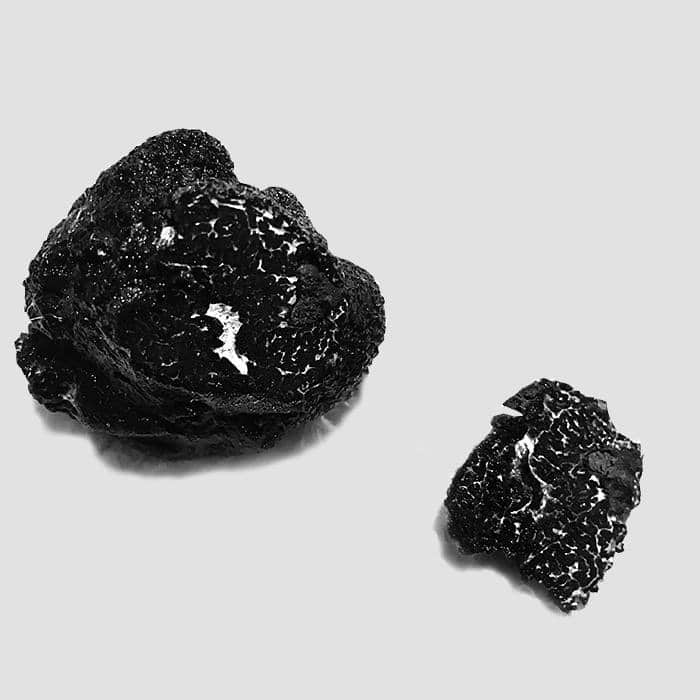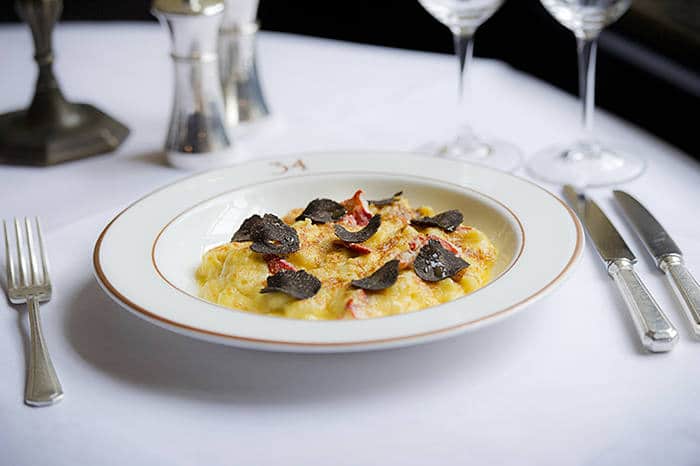How a scientist sniffed out a culinary opportunity

FT Magazine Food & Drink
Nicola Davison APRIL 20, 2018
Late one winter afternoon, in a field near Edinburgh, a scientist and a hunter are standing over a springer spaniel, watching it tear furiously at the base of a tree. Every few seconds, the dog ceases its digging, reaches down with its mouth and shakes a clod of earth as if it were a small mammal between its jaws. After a few minutes, the hunter, a retiree called Joyce, raises her hand and makes a circle gesture to the spaniel, Maxwell. “Snuffle,” she says. “Go snuffle the truffle.” And Maxwell takes off, whipping through the trees.
For Maxwell and Joyce, truffle hunting is a new pastime. A few centuries ago, truffles, the fruiting bodies of fungi that grow underground on the roots of trees, were everywhere. In her 1861 Book of Household Management, Mrs Beeton included a recipe that involved the stewing of 12 truffles in champagne. But since the 19th century, the number of wild truffles has declined. These days, epicures may have tried an Italian or French truffle, or sampled truffle oil, truffle salt or truffle honey. But to most, the UK’s indigenous truffle — Tuber aestivum, a variety that has black skin, nobbled with pyramid-shaped warts — is virtually unknown.
British truffles tend to receive more muted praise than their European counterparts. The food writer Josh Ozersky described the aroma of Italian white truffles as “a combination of newly ploughed soil, fall rain, burrowing earthworms, and the pungent memory of lost youth and old love affairs”. “Nutty” is the way British truffles are often described.
Farming truffles has long been regarded as a fool’s errand. Humankind has devised ways of cultivating almost every desirable plant, fruit and fungus, yet the truffle has, on the whole, resisted efforts to tame it. In spite of this they are highly prized by chefs, and a fixture on Michelin-star menus as shavings on salads, pasta and risottos. It is thought that demand for the best truffle species outstrips supply by a factor of 10 — supply is limited because they are so hard to grow and wild stocks are depleted — and this is reflected in their price, which has increased by four or five per cent each year for the past three decades. In 2014, a 4.16lb white truffle was auctioned in New York for $61,250.
In the field with Joyce and Maxwell is Paul Thomas, a scientist who has made the study of this elusive fungus his life’s work, and the growing of them his business. Thomas is not the first person to recognise the truffle’s commercial potential. However, unlike his predecessors, he seems to have found a way to reliably cultivate them outside their native habitat of France, Italy and Spain. He has spent years in the lab perfecting a method of artificially inoculating saplings so that when the trees mature, truffles will grow on them. Over the past decade he has been planting in orchards in England, Wales and Scotland, all places where summer truffles can be foraged in the woods but have not before been farmed.
As Maxwell makes a beeline for a hazel tree, Thomas explains that the plantation is 20 acres, totalling about 11,000 trees. Planted seven years ago, it began to produce truffles in 2016, a few years earlier than Thomas had expected — he had thought that the harsh Scottish climate might temper growth. When the orchard reaches maturity in about six years, he is expecting it to produce half a tonne of truffles a season. Online, 100g of summer truffles costs approximately £85.
Thomas, who is 37, has spent much of the day working to fit four trees with dendrometers, devices that measure micro-variations in tree trunks. “They’re so precise, you can see water going up and down the stem in a day,” he says. He has also installed soil temperature and moisture sensors underground. Data are being logged for a year for comparison to truffle yields. Eventually he hopes to understand the precise conditions required for fruiting. At the moment, it is more educated guesswork.
At the hazel tree, Maxwell is snuffling with urgency. Thomas borrows Joyce’s vanghetto, a truffle-digging tool that is something between a trowel and a pickaxe. He scrapes back the soil, exposing threadlike roots. Watching Thomas work, Joyce is sceptical. Though Maxwell unearthed a truffle a few weeks earlier, it is out of season — summer truffles typically stop fruiting in December. It is possible that the dog smells a very young, as yet unformed truffle, or one that is rotting in the ground. But she suspects he is bored.
“He doesn’t know he’s looking for truffles,” Joyce says. “He thinks that if he indicates where there’s a smell, suddenly, magically, Mum gives him his tennis ball.” The spaniel, snout glistening with mud, seems suspiciously fixated on Joyce’s coat pocket. After a couple of minutes of digging, Thomas gives up. Today there will be no truffles.
Since ancient times, truffles have been a vaunted yet mysterious delicacy. Plutarch thought that they arose from a combination of a lightning strike, warmth and water, while the Italian composer Rossini claimed to have wept three times in his life: “Once when my first opera failed. Once again, the first time I heard Paganini play the violin. And once when a truffled turkey fell overboard at a boating picnic.”
In recent years, scientists have identified some 185 different species belonging to the tuber genus growing on almost every continent. Some are as small as peas, others the size of oranges. Desert truffles grow on the roots of shrubs in north Africa and the Middle East and can be eaten like baked potatoes. The Chinese black truffle, T. indicum, is almost indistinguishable from black European truffles in appearance, but it lacks flavour and is fed to livestock. White Alba truffles are particularly expensive because they are only found in the wild, but chefs believe black Périgords (T. melanosporum) are superior in flavour. In France, truffle poaching has become so common that during high season, in late winter, the police set up roadblocks. Truffle dogs are at risk of being poisoned or stolen.
Truffles are formed when a fungus sends out the gossamer-fine tubes of its mycelium into the soil to meld with the feeder roots of trees. The fungus lives in a symbiosis with the tree, feeding it nutrients from the soil and receiving, in return, sugar via photosynthesis. After six years, if mating has occurred, the mycelium swells, forming a bulbous, spore-carrying fruit body: the truffle.
Unlike the fruit of other fungi, such as white mushrooms, which grow above ground, truffles rely on being dug out and eaten, their spores disseminated by insects and mammals. They attract animals by expelling a powerful odour and are so delicious that animals keep digging. For a long time, pigs were used to hunt for truffles but about 50 years ago they fell out of favour. Pigs have good noses but poor self-restraint.
I thought, hey, this stuff is expensive and it’s addictive. I wonder if you can grow it?
Robert Chang, co-founder
American Truffle Company
People started trying to farm truffles by more scientific methods in the 19th century. In 1808, a Frenchman called Joseph Talon grew Périgords from acorns he had collected from truffle-producing oak trees. Yet the methodology was inexact: seedlings from truffle trees did not always yield truffles. In 1970, Gérard Chevalier and Jean Grente, scientists at France’s Institut National de la Recherche Agronomique (INRA), developed a way to reliably inoculate the seeds of trees so that they carried the truffle fungus. The first commercialised truffle saplings were sold in 1973.
Today, about 90 per cent of France’s Périgords are grown in orchards. But the French plantations, along with those of Italy and Spain, do not produce enough truffles. Since the 19th century, production in France has fallen from 1,000 tonnes a season to 30 tonnes, according to Claude Murat of the INRA. The decline is attributed to changes in agriculture and warming temperatures, with prolonged drought depleting wild stocks. (Cultivated truffles are less vulnerable to climate change because they can be irrigated.) While artificially inoculated seedlings grow well in the truffles’ indigenous Mediterranean habitat, with its limestone-heavy soil, trying to plant truffle trees overseas has generally not resulted in truffles (except in Australia, where there have been thriving truffle plantations since the 1990s).
Thomas first encountered a truffle while he was working on his PhD at Sheffield University. As an undergraduate, he had read a 1997 paper by the Canadian ecologist Suzanne Simard about how different plant species communicate underground in vast mycorrhizal networks sometimes referred to as the “wood wide web”. After reading more deeply about truffle biology, he ordered a Périgord online. “I opened the packet and it flooded the house with aroma and scented everything in the fridge,” he says. “The next morning the orange juice tasted like truffle.”
Thomas thought he might try to grow a truffle at home. He found that while the methods for inoculating seedlings were more or less robust, there was scarce information on how to ensure fruiting happened. He suspected that this was the reason why there was such a high rate of failure among truffle growers. “There was one group I was reading about where a guy was pouring milk round the base of his trees and he was producing truffles, and all the other growers were like: ‘Oh, we’ll pour milk around our trees too,’” he says.
For a long time, pigs were used to hunt for truffles but about 50 years ago they fell out of favour. Pigs have good noses but poor self-restraint
Thomas began publishing papers on subjects such as the effect of climate and the role of soil pH on truffle growth. In 2006, he received an email from Robert Chang, a former Yahoo executive and an early investor in Renren, the New York Stock Exchange-listed Chinese social network. Chang, who lives near San Francisco, had first eaten truffles, shaved on top of tagliatelle tossed in butter, in Munich a few years earlier. “I thought, hey, this stuff is expensive and it’s addictive,” Chang tells me. “I wonder if you can grow it?” The science of growing truffles, he found, was not in the public domain. He looked for someone who was actively doing research and flew to London to meet Thomas in a pub near Leicester Square. “A one-hour meeting turned into a four-hour meeting.”
Chang and Thomas resolved to do things their own way. Rather than selling inoculated trees from their nursery, which is in Oregon, directly to growers, they would partner with clients, providing fungus-loaded saplings at near cost, as well as expertise, technical support and product distribution as the plantation matured, for free. (They declined to go into details about their inoculation process as their method is not patented.) In return, their firm, the American Truffle Company, would take about one-third of the profits once the plantation started fruiting. “All of a sudden that changes the incentives very significantly,” Chang says. “We are very much invested in making sure that our client-partners actually produce truffles and produce as many truffles as their land will support.”
The company begins by analysing a prospective site’s soil and climate to ensure the natural conditions are favourable. Lime can be added if the soil is too acidic. Périgords will grow up and down the west coast of the US — Thomas and Chang have a number of plantations in the Napa Valley — but on the east coast they will not survive north of Delaware. Burgundy truffles, a woodland species, are suited to the Eastern Seaboard. Chang estimates the cost of establishing a truffle orchard is between $15,000 and $25,000 per acre, depending on the species and specifics like whether a deer fence is needed. The company has planted between 150 and 200 acres in the US. No truffles have yet surfaced but Chang is confident they are on the cusp of this happening.
At the moment, the majority of Périgord and burgundy truffles consumed in the US come from France. Chang estimates that domestic truffles can be sold at between a 15 and 30 per cent premium over imports due to their freshness. (Once out the ground, truffles rapidly lose pungency.) The company plans to stop establishing new plantations soon, he says, because they do not wish to create an oversupply, tanking prices. I ask whether he is concerned that rival companies might follow their lead anyway, swamping the market. “Certainly people can start truffle orchards and people will continue to start truffle orchards, but the vast majority of them have failed and will continue to fail, simply because the science will not become publicly available any time soon,” he says. “Whoever controls the science will control the supply.”
On a drizzly morning in February, I go to the University of East Anglia in Norwich to meet the scientists who are working with Thomas on ways to improve truffle farming. Arasu Ganesan is a professor of chemical biology who specialises in epigenetics, the study of how chemical reactions in organisms influence the genome. “There’s a big drop between how many trees you inoculate and how many actually produce a truffle,” he says when we get to the lab. Blooms of fungi in shades of charcoal, ochre and moss green sit in Petri dishes. Truffle fungus, Ganesan says, is “like a black box which nobody understands”.
One mystery is what prompts truffle fungi to mate. Scientists know that they have two mating types (some fungal species have as many as 13). The maternal mating type is the one that forms the symbiosis with the tree root and the paternal type is present in the soil (though both can function in either role). “We’ve gone through this complicated differentiation between the sexes,” says Ganesan. “Theirs is complete equality.”
The big question for the scientists is whether one mating type is more common than another. The dominance of one type on a plantation is problematic because it would likely impact the efficiency of mating and, in turn, truffle yield. “If we create trees that contain only one or the other mating type, they could be distributed in a logical way through the plantation to facilitate mating,” says Philip Schuler, a PhD student and UEA’s resident authority on truffle mating habits. The scientists are also analysing compounds that occur naturally in the soil to see if any have properties that might be useful. If they manage to find a chemical, say, that encourages truffles to mate it could be made into a fertiliser.
Not long after visiting Scotland, I telephone the owner of one of the UK’s oldest truffle plantations, this time in Wales. Matt Sims, who works in precious metals, turned to truffles because he did not know what else to do with his spare 11 acres. “I needed to do something with the land that was low maintenance and with a potential nice return,” he says. After reading a few books on truffles, he got in touch with Paul Thomas.
Over the winter of 2008-09, Sims and Thomas planted 5,000 hazels and oaks inoculated with summer truffle fungus. Eight years later, Sims and his dogs found their first batch. Since then, he has found about 150 specimens that he has sold mostly to restaurants. This season, he expanded to sell directly to consumers through his website, the Welsh Truffle Company. “At the moment only about 35 trees are fruiting,” he says. “The year before only three were fruiting. So if the trend continues I’m expecting about 300 to fruit this year, and 3,000 the year after.” Managing a truffle orchard that size, he admits, would not be the low-maintenance money-spinner he had planned for in the beginning.
In the middle of his orchard, Sims is running a small experiment. There, among the hazels, he has planted four Mediterranean oak saplings that have been inoculated with Périgord fungus. This was against Thomas’s advice. The Périgord’s ecological range was assumed to be limited to chalky soils with a climate a good deal balmier than that of Wales; the furthest north they had been found was Lorraine in France.
But in March last year, one of Sims’s dogs unearthed a ripe Périgord, a high-quality specimen weighing 16g. Sims had anticipated its arrival because the vegetation around the base of the tree had died, indicating that the fungus below was thriving. Since then, he has found a dozen more. Much of England and Wales has a similar soil profile and climate to Sims’s site, raising the possibility that one day there could be a trade in British-grown Périgords.
For now, there are just the four trees. I ask Sims if he worries about poachers. “On the continent there’s been truffle wars for centuries, they poison each other’s dogs and they fight over ground,” he says. “But this is Wales. Nobody round here would think of it.”
Follow @FTMag on Twitter to find out about our latest stories first. Subscribe to FT Life on YouTube for the latest FT Weekend videos
Copyright The Financial Times Limited 2018. All rights reserved.
The original article is available at the Financial Times here.









